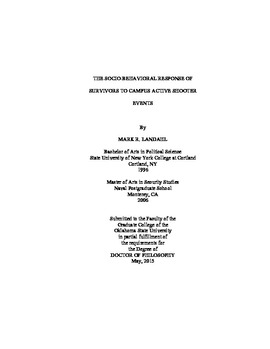| dc.contributor.advisor | Neal, David | |
| dc.contributor.author | Landahl, Mark R. | |
| dc.date.accessioned | 2016-09-29T18:35:39Z | |
| dc.date.available | 2016-09-29T18:35:39Z | |
| dc.date.issued | 2015-05 | |
| dc.identifier.uri | https://hdl.handle.net/11244/45180 | |
| dc.description.abstract | This research uses available secondary data from two incidents on college campuses to analyze survivor behavior in response to campus-based active shooter events. The study employs a qualitative inductive design using grounded theory methodology within a multiple case study strategy. Themes in survivor behavior develop across the cases. The study results in the development of a data-grounded Active Shooter Behavioral Response Model (ASBRM), which traces the behavioral response of survivors from incident recognition to implementation and reassessment of protective behaviors. The model details environmental cues, social cues, and social interaction leading to information gathering activities that result in protective behavior implementation and reassessment. The model shows similar characteristics to models developed to explain behavior in other event types. The theoretical assessment of the ASBRM shows the application of the emergent norm theory of collective behavior with consideration for ecological factors that affect the operation of the model. | |
| dc.description.abstract | The study advances four findings related to survivor behavior in campus active shooting events. (1) Survivor response is social rather than asocial and includes helping behavior between survivors consistent with research findings in other disaster event types. (2) Survivors process environmental cues, social cues, and engage in social interaction to define the situation, gather information, and implement and reassess protective behavior choices within a framework that maintains and extends social and organizational roles. (3) Survivors implement protective behaviors that include taking cover on the floor, running to evacuate, running to shelter, hiding, using available resources to barricade themselves, locking door, turning off lights, and barricading doors. (4) Survivors show group level interaction for confirmation of environmental cues and processing of additional incident cues that lead to: (1) implementation of protective actions and (2) the division of tasks for information gathering and implementation and (3) reassessment of protective behaviors. | |
| dc.format | application/pdf | |
| dc.language | en_US | |
| dc.rights | Copyright is held by the author who has granted the Oklahoma State University Library the non-exclusive right to share this material in its institutional repository. Contact Digital Library Services at lib-dls@okstate.edu or 405-744-9161 for the permission policy on the use, reproduction or distribution of this material. | |
| dc.title | Socio-behavioral response of survivors to campus active shooter events | |
| dc.contributor.committeeMember | Webb, Gary | |
| dc.contributor.committeeMember | Naile, Traci | |
| dc.contributor.committeeMember | Phillips, Brenda | |
| osu.filename | Landahl_okstate_0664D_13948.pdf | |
| osu.accesstype | Open Access | |
| dc.type.genre | Dissertation | |
| dc.type.material | Text | |
| thesis.degree.discipline | Fire and Emergency Management Administration | |
| thesis.degree.grantor | Oklahoma State University | |
